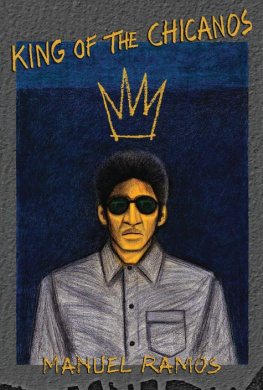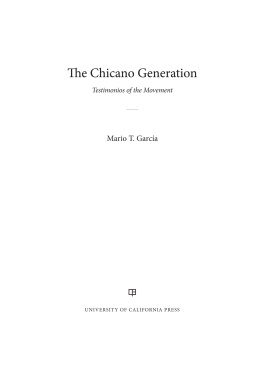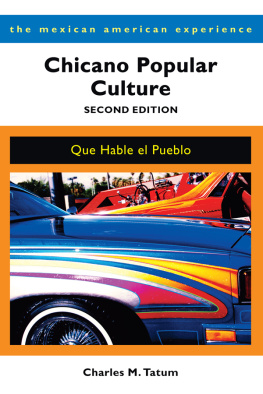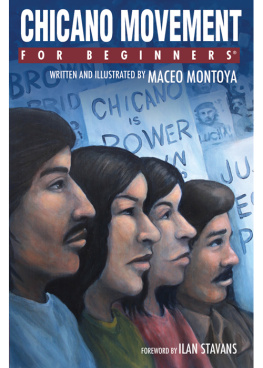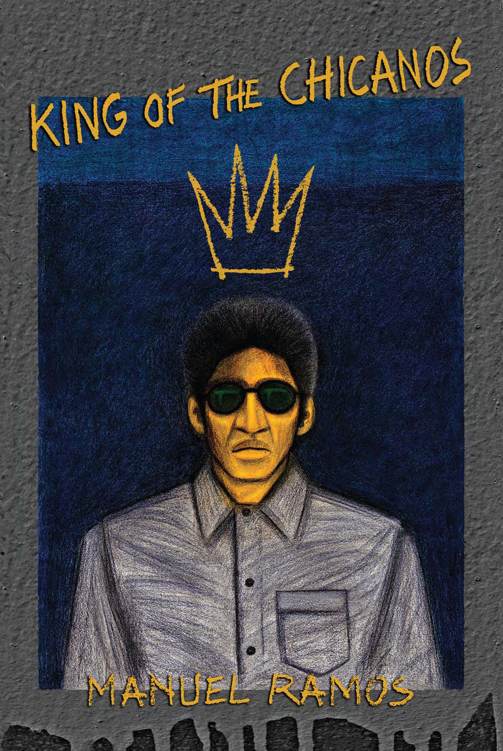A Nove l
Manuel Ramo s

San Antonio, Texas2010 King of the Chicanos 2010 by Wings Press for Manuel Ramos
Cover art: Bato con Sunglasses 2003 by Csar Martne z Digital Dimension Print from a charcoal and pastel drawing matrix . Edition of 22. 42 x 30
Quote from Pedro Pramo by Juan Rulfo, originally published in Mexico in 1955 . English translation by Margaret Sayers Peden. Copyright 1994 by Northwester n University Press. Used by permission of Grove/Atlantic, Inc .
First Editio n Print Edition ISBN: 978-0-916727-64- ePub ISBN: 978-1-60940-006- Kindle ISBN: 978-1-60940-007- PDF ISBN: 978-1-60940-008-
Wings Pres s 627 E. Guenthe r San Antonio, Texas 7821 Phone/fax: (210) 271-780
On-line catalogue and ordering : www.wingspress.co m All Wings Press titles are distributed to the trade b y Independent Publishers Group www.ipgbook.co m
Library of Congress Cataloging-in-Publication Data:
Ramos, Manuel . King of the Chicanos : a novel / Manuel Ramos. -- 1st ed .
p. cm.All Wings Press titles are distributed to the trade by Independent Publishers Group.Includes bibliographical references.
ISBN 978-0-916727-64-2 (pbk. : alk. paper) --ISBN 978-1-60940-006-4 (epub) --ISBN 978-1-60940-007-1 (kindle) --ISBN 978-1-60940-008-8 (library pdf )
Mexican Americans--History--20th century--Fiction. 2. Mexican
Americans--Civil rights--Fiction. 3. Chicano movement--Fiction. I. Title . PS3568.A4468K56 201
813.54--dc22 2010004351
Except for fair use in reviews and/or scholarly considerations,no portion of this book may be reproduced in any form without the written permission of the author or the publisher.
For my grandchildren
Av a Emanue l Jade n Maso n Nic o Nikk o Tiann a
Contents
Groans and Whispers
The Peoples Strength
Lets Get It On
Las Cuatro Milpasas sung by Cuarteto Carta Blanca
An Incomplete List of Non-fiction Books About the Chicano Movement
About the Author
Authors not e
This is a work of fiction. As such, it takes place primarily in the fictional city of Escobar, a metropolitan area in an unnamed southwestern state.
Many thanks to Lucha Corpi and Rolando Hinojosa, two extraordinary writers who sacrificed valuable time and demonstrated commendable patience when they read an early version of this book and then provided me with guidance and feedback; to Michael Sedano, blogger and literary gourmet, who likewise commented and critiqued; to Rudolfo Anaya and his sanctuary in Jmez Springs; to Alfredo Va, for Gods Go Begging; and to Chico Martnez, who understood.
usage not e
The term Aztln is used with an accent, as it was throughout the time periods represented in King of the Chicanos. The use of the accent probably derived from Aluristas use of it in his seminal poem, El Plan Espiritual de Aztln. However, Nahuatl does not use accents, and current usage generally recognizes that fact.
A Chicano is a Mexican-American with a non-Anglo image of himself.
Ruben Salazar Who Is a Chicano? And What Is It the Chicanos Want? Los Angeles Times, February 6, 1970
Since we are running a campaign of The People, it is not for me or for any of my associates to determine to what extent or in what manner you or any group with whom you associate should take up the banner. The responsibility and obligation must be yours and yours alone. If we are to be successful, it must come from the desire of The People to be free, totally free from those who oppress them. No man can tell another how, or even if he should be free. Therefore, we will not make any attempt to have an organization for this campaign. As the saying goes, youve got to Do Your Own Thing!
Justicia y Libertad.
Oscar Zeta Acosta Declaration of Candidacy for the Office of Sheriff of Los Angeles CountyFebruary 23, 1970
All right. What can I do for you? Pedro Pramo repeated.
Like you see, weve taken up arms.
And?
And nothing. Thats it. Isnt that enough?
But why have you done it?
Well, because others have done the same. Didnt you know? Hang on a little till we get our instructions, and then well tell you why. For now, were just here.
Juan Rulfo, from Pedro Pramo
I :
Chato, Sal, and Ra y Sh-Boo m
Groans and Whisper s
Las Trampas, New Mexico1999
On another dry, hot summer day in the last year of another century, Pancho Arango stood in line by an open casket in a packed, abbreviated version of a church in northern New Mexico. The good and religious people of Las Trampas had resurrected San Jos de Gracia from ruin. They had patched the crumbling adobe, reinforced the ceiling and walls, and painstak ingly applied a thick coat of sealant to the wooden floor that covered graves dating from the eighteenth century. Although he tried to lose himself in the heavenly mythology of the tor pid funeral mass and the somber throng of mourners, he found himself reflecting on the secular life and times of a man he had loved and hated, feared and pitied.
He had promised himself that he would not attend the funeral of Ramn Hidalgo. The promise did him no good.He failed in the same way that he failed when he had tried to erase the part Hidalgo had played in his life. When the time came, Arango broke the promise without understanding what it meant. He had to be present when Hidalgo received his peace and his place in history and thus he broke his promise without hesitation, without calculating what the cost would be, what the price for attendance had to be.
The sunburned farmer ahead of Arango in the viewing line wore an ill-fitting black suit that exposed frayed cuffs of a shirt that once had been blazing white and an inch-and-a-half of gray socks that once had been midnight black. The mans bushy, gray eyebrows, full head of gray hair that hung over the frazzled shirt collar, and the glassy, yellow eyes shielded his identity for several minutes, but just as he moved away from the coffin Arango recognized the scarthe mark of the man who had stood next to him while policemen jabbed heavy metal batons at both of them, who had run with Arango when an errant missile of tear gas landed at their feet and exploded in the faces of the policemen.
Hidalgos dark, waxen face, surrounded by silk and velvet,glowed with serenity. Arangos dulled senses strained against the uneasy peace that tried to overwhelm him.The inert body in the lustrous coffin, the deep-eyed, gravely-voiced priest, the somber,medieval church, the tense mourners: these images served their orchestrated purpose and what should have been a loud, wild celebration of a wild, demanding life was only another church funeral, one more procession of grief and prayer and fear. The fiery, glowing eyes were closed and the half-smile beneath the thin mustache betrayed the irony that even in death Hidalgo understood.
Arango found his way to a pew and sat on the hard wooden seat. Summer burned the wild flowers and weeds and heated the earth but inside the cool air of the adobe building comforted all.A panel of brightly colored, vividly detailed retablos framed the altar. San Isidro smiled ambiguously as a sweating angel plowed his fields. San Francisco stared off to the distant right, a skull in the background. San Miguel brandished a sword that dripped blood. The black San Martn de Porres lovingly cradled the Christ child, and The Little Flower clutched her heart and cried the tears of martyrdom for those who refused to see the beauty and power of the one true God.

